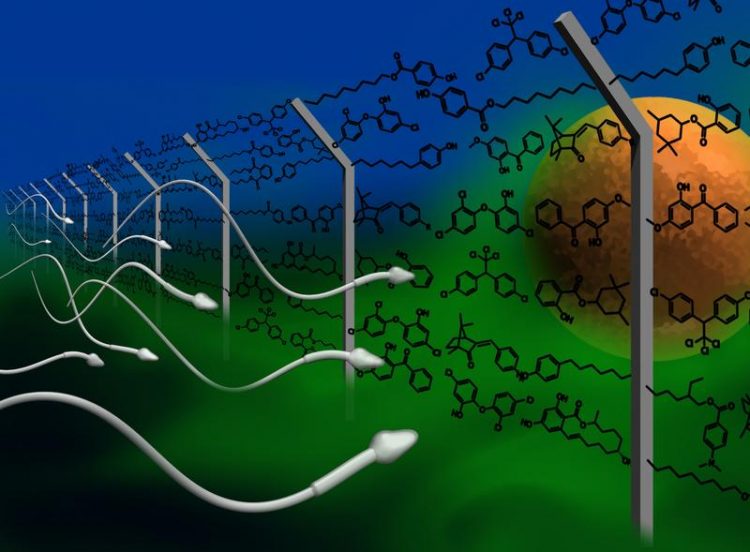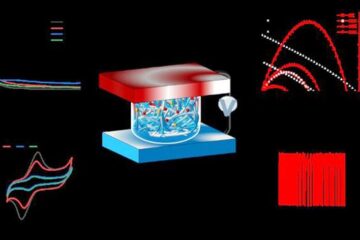Endocrine disruptors impair human sperm function

Chemical fences: some substances in our everyday life may hamper penetration into the protective coat of the egg cell. © EMBO Reports, 2014
A plethora of endocrine-disrupting chemicals interfere with human sperm function in a way that may have a negative impact on fertilization. These are the findings of a German – Danish team of researchers from the Center of Advanced European Studies and Research in Bonn, Germany, and the University Department of Growth and Reproduction, Rigshospitalet, Copenhagen, Denmark. The work, which is published in EMBO reports, suggests that endocrine disruptors may contribute to widespread fertility problems in the Western world in a way that hitherto has not been recognized.
Endocrine disruptors are present in food, textiles, drugs, household, and personal-care products such as plastic bottles, toys, and cosmetics. Proving the deleterious effects of endocrine disruptors on human beings has been difficult due to a lack of suitable experimental systems.
The European Commission is currently reviewing its policy on endocrine-disrupting chemicals. Last year, their plans caused a debate between endocrinologists and a group of toxicologists over how to regulate these chemicals. “Our study provides scientific evidence to assist forming international rules and practices,” said the leader of the study, Timo Strünker, from the Center of Advanced European Studies and Research in Bonn, Germany.
“For the first time, we have shown a direct link between exposure to endocrine disrupting chemicals from industrial products and adverse effects on human sperm function,’’ said Niels E. Skakkebaek, professor and leader of the Danish team.
Hundreds to thousands of chemicals can be rapidly tested for their potential to interfere with human sperm function using the bioassay developed by the researchers. In this initial study, about one hundred chemicals were tested. Around one third, including ultraviolet (UV) filters like 4-methylbenzylidene camphor (4-MBC) used in some sunscreens, the anti-bacterial agent Triclosan used in toothpaste, and di-n-butylphthalate (DnBP), showed adverse actions.
The scientists looked at the impact of these chemicals on the CatSper ion channel, a calcium channel controlling sperm motility. They showed that endocrine disruptors – applied at concentrations measured in body fluids – directly open CatSper and, thereby, increase calcium levels in sperm, change their swimming behaviour, and trigger the release of digestive enzymes that help sperm to break through the egg coat. Moreover, endocrine disruptors render sperm less sensitive for progesterone and prostaglandins – two important hormones released by cells surrounding the egg. Finally, the authors noted that in low-dose mixtures, the chemicals cooperate to elevate calcium levels in sperm.
Altogether, the study indicates that endocrine disruptors might disturb the precisely coordinated sequence of events underlying fertilization in several ways: the chemicals might evoke changes in swimming behaviour at the wrong time and wrong place, hinder navigation of sperm towards the egg, and hamper penetration into the protective egg coat.
Contact
Stefan Hartmann
Research Center caesar (center of advanced european studies and research), Bonn
Phone: +49 228 9656-292
Fax: +49 228 9656-9292
Timo Strünker
Research Center caesar (center of advanced european studies and research), Bonn
Phone: +49 228 9656-162
Fax: +49 228 9656-9162
Media Contact
All latest news from the category: Health and Medicine
This subject area encompasses research and studies in the field of human medicine.
Among the wide-ranging list of topics covered here are anesthesiology, anatomy, surgery, human genetics, hygiene and environmental medicine, internal medicine, neurology, pharmacology, physiology, urology and dental medicine.
Newest articles

Superradiant atoms could push the boundaries of how precisely time can be measured
Superradiant atoms can help us measure time more precisely than ever. In a new study, researchers from the University of Copenhagen present a new method for measuring the time interval,…

Ion thermoelectric conversion devices for near room temperature
The electrode sheet of the thermoelectric device consists of ionic hydrogel, which is sandwiched between the electrodes to form, and the Prussian blue on the electrode undergoes a redox reaction…

Zap Energy achieves 37-million-degree temperatures in a compact device
New publication reports record electron temperatures for a small-scale, sheared-flow-stabilized Z-pinch fusion device. In the nine decades since humans first produced fusion reactions, only a few fusion technologies have demonstrated…





















